(骨干教师竞赛作品)八年级英语上册《8A Unit 6 Natural Disasters》实践报告 牛津版
- 格式:doc
- 大小:31.00 KB
- 文档页数:2
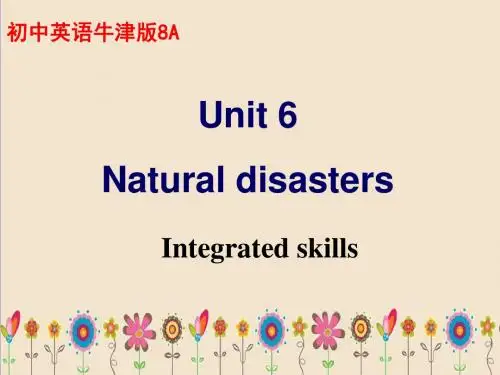
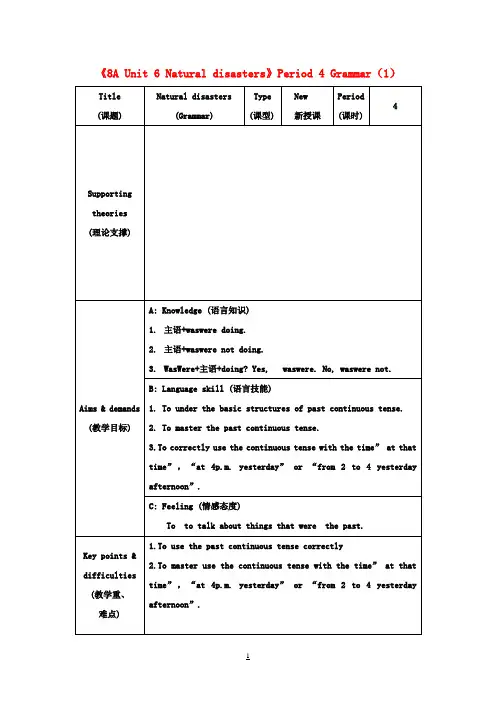
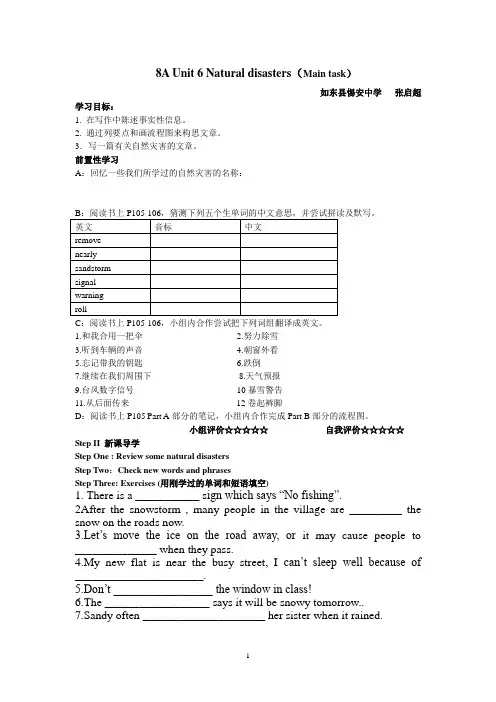
8A Unit 6 Natural disasters(Main task)如东县惕安中学张启超学习目标:1. 在写作中陈述事实性信息。
2. 通过列要点和画流程图来构思文章。
3.写一篇有关自然灾害的文章。
前置性学习A:回忆一些我们所学过的自然灾害的名称:_____________________ ____________ ______________________ ___________ ____________ ____________C:阅读书上P105-106,小组内合作尝试把下列词组翻译成英文。
1.和我合用一把伞_____________________2.努力除雪________________________3.听到车辆的声音_____________________4.朝窗外看________________________5.忘记带我的钥匙_____________________6.跌倒____________________________7.继续在我们周围下__________________ 8.天气预报________________________9.台风数字信号_______________________ 10暴雪警告________________________11.从后面传来________________________ 12卷起裤脚________________________D:阅读书上P105 Part A部分的笔记,小组内合作完成Part B部分的流程图。
小组评价☆☆☆☆☆自我评价☆☆☆☆☆Step II 新课导学Step One : Review some natural disastersStep Two:Check new words and phrasesStep Three: Exercises (用刚学过的单词和短语填空)1. There is a ___________ s ign which says “No fishing”.2After the snowstorm , many people in the village are _________ the snow on the roads now.3.Let’s move the ice on the road away, or it may cause people to ______________ when they pass.4.My new flat is near the busy street, I can’t sleep well because of ______________________.5.Don’t _________________ the window in class!6.The __________________ says it will be snowy tomorrow..7.Sandy often _____________________ her sister when it rained.Step Four:Know more about the notes1.Read Sandy’s notes , ask questions in groups and try to know more details about Snowstorm2. Read the notes together,discuss the notes in groups and try to know these notes which were used to describe the content (小组讨论这些笔记分别用于描述哪方面的内容)3.Look at the flow chart , analyze the structure of the flow chart(分析流程图的结构)4. Ask questions about Sandy’s flow chart , then check out the answers.Step Five:Learn more about the article “A snowstorm hit Beijing”1. Skim the article quickly (快速浏览短文), analyze of each paragraph belong to which part of the flowchart(分析每个段落分别属于流程图中的哪个部分。
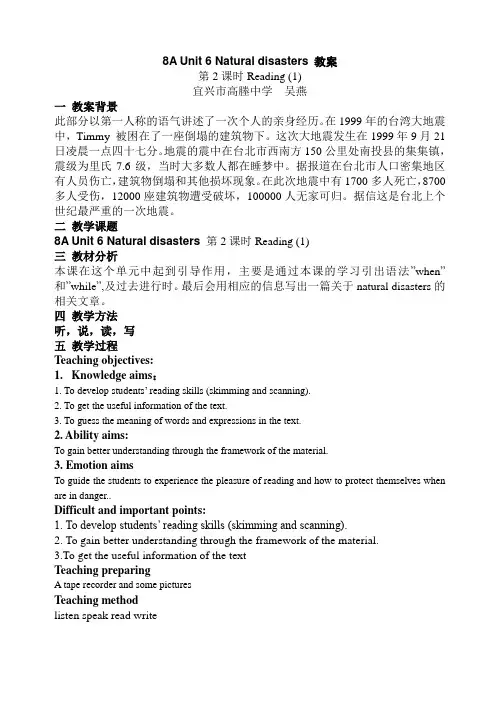
8A Unit 6 Natural disasters 教案第2课时Reading (1)宜兴市高塍中学吴燕一教案背景此部分以第一人称的语气讲述了一次个人的亲身经历。
在1999年的台湾大地震中,Timmy 被困在了一座倒塌的建筑物下。
这次大地震发生在1999年9月21日凌晨一点四十七分。
地震的震中在台北市西南方150公里处南投县的集集镇,震级为里氏7.6级,当时大多数人都在睡梦中。
据报道在台北市人口密集地区有人员伤亡,建筑物倒塌和其他损坏现象。
在此次地震中有1700多人死亡,8700多人受伤,12000座建筑物遭受破坏,100000人无家可归。
据信这是台北上个世纪最严重的一次地震。
二教学课题8A Unit 6 Natural disasters 第2课时Reading (1)三教材分析本课在这个单元中起到引导作用,主要是通过本课的学习引出语法”when”和”while”,及过去进行时。
最后会用相应的信息写出一篇关于natural disasters的相关文章。
四教学方法听,说,读,写五教学过程Teaching objectives:1.Knowledge aims:1. To develop students’ reading skills (skimming and scanning).2. To get the useful information of the text.3. To guess the meaning of words and expressions in the text.2. Ability aims:To gain better understanding through the framework of the material.3. Emotion aimsTo guide the students to experience the pleasure of reading and how to protect themselves when are in danger..Difficult and important points:1. To develop students’ reading skills (skimming and scanning).2. To gain better understanding through the framework of the material.3.To get the useful information of the textTeaching preparingA tape recorder and some picturesTeaching methodlisten speak read writeTeaching procedures:Step 1. Pre-checking词组翻译在一个购物中心_____________________________恐惧地互相看着______________________________破碎玻璃片_________________________________一阵恐惧___________________________________吃一包巧克力_______________________________a slight shaking _______________________________run in all directing ____________________________clam down __________________________________shout for help ________________________________stay here for a long time __________________________Step 2 Presentation1. Show some pictures of natural disasters to present the topic of this unit – natural disasters2 Present the topic of reading – earthquakeGet the students to discuss:In your opinion, what is the most dangerous kind of natural disaster?Show some pictures of earthquakes3 Teach some new words:The teacher ask the students: What happened during the earthquake?Shake, bomb, fear, scream, direction, wildly.glass.bricksStep 3 Reading1. Get the students to skim the article and find the answer to the question:Did Timmy give up or try his best to survive when he was in danger during the earthquake?2 .Read the article for detailed information1) When the earthquake came, what did Timmy feel/ hear/see/do?2) How did Timmy save himself after he was trapped?3) How did other people save Timmy?3.Read the article for further understanding1) Listen to the tape and finish Exercises C, textbook Page 972) Read with feelings and finish Exercises D, textbook Page 97Step 4 Sum up1.We know about Timmy’s whole story.2.We learn some important phrases and sentences.3.We know how to save ourselves when we are in danger.Step5 Exercises & HomeworkThink of ways of saving yourself during other natural disasters, write them down . Do the exercises in Part B, Page 96.Try to say something about the main idea of the article.教学反思:通过快读,精读来回答问题,在做书本后的题目时,根据图片写句子中,第一幅图和第五幅的描述学生领会不清,part D判断正误,学生的答案85%是正确的,学生对课文内容了解,为reading的第二课时作好铺垫。
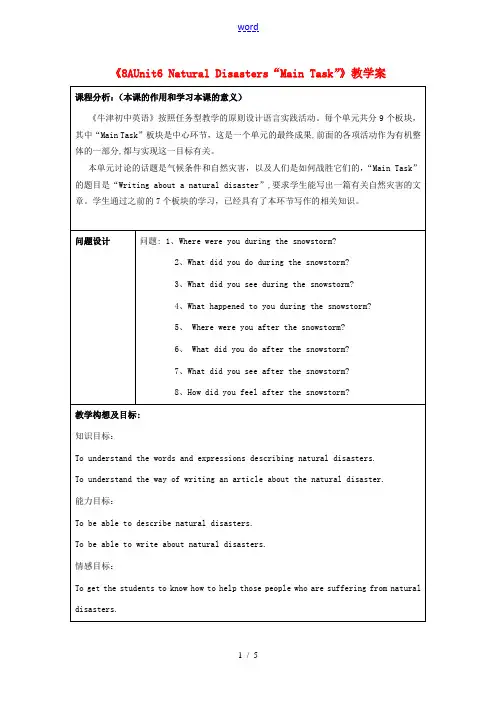
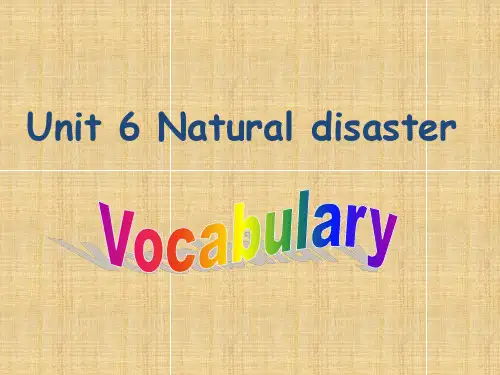
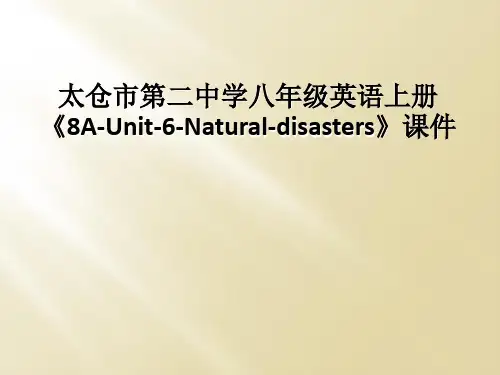
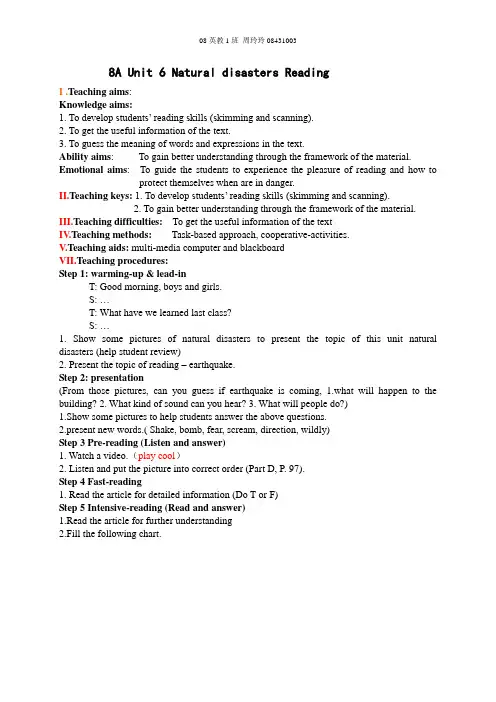
8A Unit 6 Natural disasters ReadingI .Teaching aims:Knowledge aims:1. To develop students’ reading skills (skimming and scanning).2. To get the useful information of the text.3. To guess the meaning of words and expressions in the text.Ability aims: To gain better understanding through the framework of the material. Emotional aims: To guide the students to experience the pleasure of reading and how to protect themselves when are in danger.II.Teaching keys:1. To develop students’ reading skills (skimming and scanning).2. To gain better understanding through the framework of the material. III.Teaching difficulties:To get the useful information of the textIV.Teaching methods:Task-based approach, cooperative-activities.V.Teaching aids: multi-media computer and blackboardVII.Teaching procedures:Step 1: warming-up & lead-inT: Good morning, boys and girls.S: …T: What have we learned last class?S: …1. Show some pictures of natural disasters to present the topic of this unit natural disasters (help student review)2. Present the topic of reading – earthquake.Step 2: presentation(From those pictures, can you guess if earthquake is coming, 1.what will happen to the building? 2. What kind of sound can you hear? 3. What will people do?)1.Show some pictures to help students answer the above questions.2.present new words.( Shake, bomb, fear, scream, direction, wildly)Step 3 Pre-reading (Listen and answer)1. Watch a video.(play cool)2. Listen and put the picture into correct order (Part D, P. 97).Step 4 Fast-reading1. Read the article for detailed information (Do T or F)Step 5 Intensive-reading (Read and answer)1.Read the article for further understanding2.Fill the following chart.Step 6: Practice & Consolidation1. Play the tape for the students to listen and repeat. Then get the students to read the article loudly.2. Ask the students to discuss: How to save yourselves when you are in danger?3.First ,I will show some pictures to them. Let them write down their feelings.(work in pairs, let students make a interview)S1: What can you see form this picture?S2: …S1: what do you feel after seeing this ?S2:S1: What will you do to help the alive people?S2: Show our love and ……4.Let them act it out.Step 7: Homework1. Surf the Internet to find more information about how to protect yourself and help others when you are in danger, write it down.How he feltWhat he heardWhat he sawWhat he did Where he was Finally At first Then。
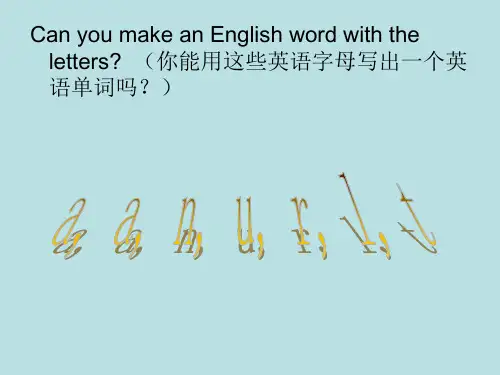
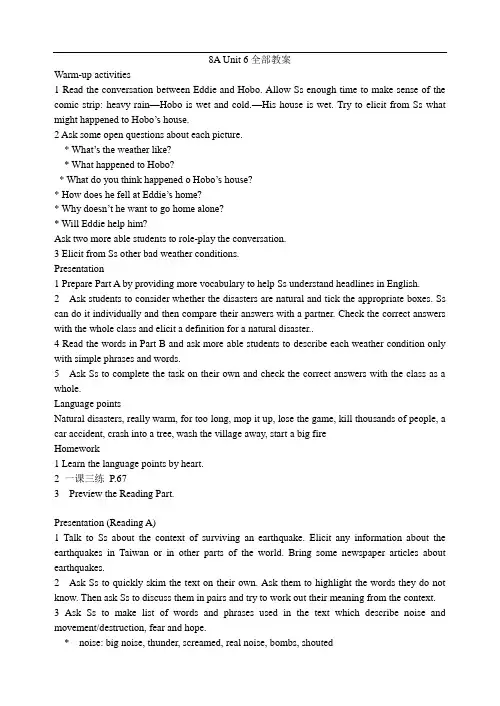
8A Unit 6全部教案Warm-up activities1 Read the conversation between Eddie and Hobo. Allow Ss enough time to make sense of the comic strip: heavy rain—Hobo is wet and cold.—His house is wet. Try to elicit from Ss what might happened to Hobo’s house.2 Ask some open questions about each picture.* What’s the weather like?* What happened to Hobo?* What do you think happened o Hobo’s house?* How does he fell at Eddie’s home?* Why doesn’t he want to go home alone?* Will Eddie help him?Ask two more able students to role-play the conversation.3 Elicit from Ss other bad weather conditions.Presentation1 Prepare Part A by providing more vocabulary to help Ss understand headlines in English.2 Ask students to consider whether the disasters are natural and tick the appropriate boxes. Ss can do it individually and then compare their answers with a partner. Check the correct answers with the whole class and elicit a definition for a natural disaster..4 Read the words in Part B and ask more able students to describe each weather condition only with simple phrases and words.5 Ask Ss to complete the task on their own and check the correct answers with the class as a whole.Language pointsNatural disasters, really warm, for too long, mop it up, lose the game, kill thousands of people, a car accident, crash into a tree, wash the village away, start a big fireHomework1 Learn the language points by heart.2 一课三练P.673 Preview the Reading Part.Presentation (Reading A)1 Talk to Ss about the context of surviving an earthquake. Elicit any information about the earthquakes in Taiwan or in other parts of the world. Bring some newspaper articles about earthquakes.2 Ask Ss to quickly skim the text on their own. Ask them to highlight the words they do not know. Then ask Ss to discuss them in pairs and try to work out their meaning from the context.3 Ask Ss to make list of words and phrases used in the text which describe noise and movement/destruction, fear and hope.* noise: big noise, thunder, screamed, real noise, bombs, shouted* movement/destruction: slight shaking, earth started to shake, ran (wildly), pieces of glass and bricks fell down, walls began to come down* fear: screamed, frightened, dark, could not at all, a moment of fear* hope: calm down, still alive, bright daylight, safe4 Read Timmy’s story aloud. Ask Ss to listen carefully.5 Check general understanding of the different paragraphs by asking some ‘ wh-‘ questions. Para 1: Where was Timmy?What happened in the shopping centre?Para 2: What happened to the building?How did people react?What did Timmy do?Para 3: Where was Timmy when the shaking stopped?How did Timmy feel?Para 4: What did Timmy do while he was waiting for help?Para 5: How was he rescued?Presentation (Reading B)1 Explain the context of Part B. Ask students to do Part B1 on their own. Encourage students to check their answer with a partner.3 Ask students to study the words in the box for one minute, then cover them and complete the diary entry in Part B2.Presentation (Reading C)1 Explain the context and point out to Ss the idea of telling a story with pictures. Divide the class into teams of 4-5 students to study each picture first.2 Ss write the captions in the blanks individually. Check answers with the whole class.3 Ask Ss to arrange the pictures in the right order.Presentation (Reading D)1 Explain the context and remind them about story telling from memory. Ss work in pairs to complete the task.2 Check the answers with the whole class.Language points (Part A)Feel a slight shaking through my body, a big noise like thunder, in fear, be frightened, start to shake, run in all directions, know where to go, run wildly, fall down, calm down, be over, could not see at all, be trapped, say to oneself, a moment of fear, go through my mind, since, hear excited shouts, in a great hurry, move away, see the bright daylight.Language points (Part C)Be very good at telling jokes, voteHomework1 Learn the language points by heart.2 一课三练P.68-693 Preview the V ocabulary Part.。
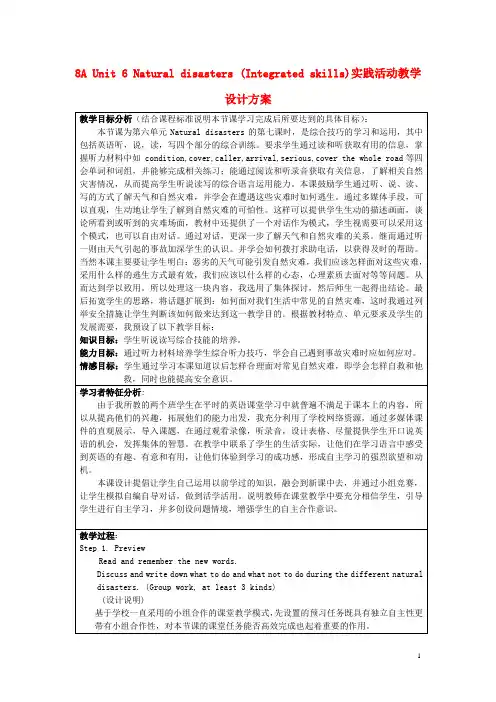
牛津英语8A Unit 6 复习讲义想法;精神指某人对某件事情的看法、观点(是纯粹的个【小试牛刀】1. He has no idea how to deal with it. 他不知道怎么去把这个事处理好。
2. The man changed his mind in the end. 这个男子最后改变了主意。
3. In my opinion, it’s easy for us to finish the work on time.在我看来,我们很容易准时完成工作。
1. He had a strange way of making his classes___________and interesting.2. We found the snake _____________.3. He said he had seen a___________whale.3. “名词+by+名词”短语此类短语大多含有“一个一个”之意,或“逐渐”的意思,强调变化,在句中做状语。
例如:Our knowledge is increasing year by year. 我们的知识逐年增长。
二、语法点拨1. 基本用法过去进行时表示过去某一时刻或某一阶段正在进行着的动作,一般与表示过去的时间状语,如: then, at that time, at six, (at this time)yesterday, from 8 to 10 last night等连用;但有时没有这些时间状语,而通过上下文的联系来表示。
①表示过去某一时刻正在进行的动作。
What were you doing at eight this morning? 今天早晨八点钟你在做什么?She was working on the problem this time yesterday. 她昨天这时候正在解那道题。
②表示过去某一阶段内的连续性动作。
What was Tom doing during the summer holidays? 汤姆在暑假期间都做了什么了?We were visiting various museums is London when we stayed there.在伦敦逗留期间,我们参观了各种博物馆。
“8AUnit 6 Natural disasters(Integrated skills)”教学实践报
告
(指导思想,设计方法等说明)
“自然灾害”是人类依赖的自然界中所发生的异常现象,自然灾害对人类社会所造成的危害往往是触目惊心的。
学生所熟知的自然灾害有地震、火山爆发、泥石流、海啸、台风、洪水等突发性灾害.人类要从科学的意义上认识这些灾害的发生、发展以及尽可能减小它们所造成的危害,这已是国际社会的一个共同主题。
八年级学生对自然灾害相关知识了解的已经不少,联系生活在课堂上应该有较强的口语表达能力,所以如果采用观看video,穿插各种相关问题设计、自主学习、分组讨论的方法,学生对本课学习将会有浓厚的兴趣,且学生能够充分发挥想像讨论出各种自然灾害带来的后果及正确处理方法。
从课程本身来讲,本节课为牛津英语8A第6单元Natural disasters的第七课时,是综合技巧的学习和运用,其中包括英语听,说,读,写四个部分的综合训练。
通过读和听获取有用的信息,掌握听力材料中如caller, cover, be covered with, arrival, serious, weather condition等四会单词和词组,并能够完成相关练习;能通过阅读和听录音获取有关信息,了解紧急求助电话中需用到的关键表达法。
同时要求学生根据从A1、A2录音中获取的信息完成A3中的一份事故报告单,培养细听技能。
从而提高学生听说读写的综合语言运用能力。
能模仿书本第103页Part B中 Sandy 和Amy的对话,谈论各种natural disasters,掌握相关句型表达,并进行简单的谈论从而指导并运用现实生活中遇到的各种自然灾害。
在教学设计中,抓住上述特点,根据课程需要,设定了一系列相关问题,让学生在事先找好的“自然灾害网页”上,查找、搜集、整合相关资料,形成结果。
如本章节是由一个听力练习表格,一个在此基础上完成邮件的练习以及一个谈论自然灾难的对话组成的。
本人在上这堂课的时候对教材作了调整,并增加了一些相关内容。
如:在热身的时候就以谈论天气的格言复习本章部分词汇内容,接着以video的形式再现自然灾害内容。
在处理对话与听力的时候把顺序作了调整。
采取先说后听的步骤。
此外,在完成邮件以后增加了一个discussion。
Discussion环节,增加了孙氏夫妇用了手机及时求助得以在暴风雪中获救,那么如果是学生自己遇到被困,没有手机怎么办呢?等,接着将学生分成2人或4人小组,讨论What can we learn from the accidents? How can we prevent the accidents? 课时最后还列举了一些学生课堂上可能没想到的一些安全措施。
如We must follow the traffic rules. Don’t make phone calls while driving. Don’t carry someone on a bike.等,继而将“Safety is above everything.”重点板书在黑板,让学生通过学习本课知道以后怎样合理面对常见自然灾难和提高安全意识。
一、实践过程
1.借助video,引入新课
借助生活中已经发生过的各种自然灾难,如唐山地震、玉树地震、雪暴、海啸等引出本课的学习内容:孙氏夫妇遇到了暴风雪该怎么办呢?
2.学生分组讨论已选问题、汇报分享
课前设定好几个研究问题,让学生自主选择感兴趣的题目,在老师自制的“自然灾害网
站”上进行自主探究,获得知识。
课上,先是小组内交流,再在班级里汇报分享成果。
3.利用学生对问题的讨论结果,展开课文的学习
借助学生对问题的讨论结果,引导学生进入文本的学习,理解课文,掌握听力技巧。
4.小结、布置编写对话、拓展学习成果
学生谈这节课的收获,老师提出围绕各种自然灾害编写对话要求,用以拓展学生的学习成果,引导学生从课本知识向实际生活过渡。
二、收获与体会
1.本课主要让学生通过听,说,看,写的方式了解天气和自然灾难,并学会在遭遇这些灾难时如何逃生。
在本课设计中,通过多媒体手段,可以直观,生动地让学生了解到自然灾难的可怕性。
这样可以提供学生生动的描述画面,谈论所看到或听到的灾难场面,导入课题。
2.教材中还提供了一个对话作为模式,学生视需要可以采用这个模式,也可以自由对话。
通过对话,更深一步了解天气和自然灾难的关系。
继而通过听一则由天气引起的事故加深学生的认识。
并学会如何拨打求助电话,以获得及时的帮助。
当然本课主要要让学生明白:恶劣的天气可能引发意外事故和自然灾难,我们应该怎样面对这些事故和灾难,采用什么样的逃生方式最有效,我们应该以什么样的心态,心理素质去面对等等问题。
从而达到学以致用。
所以处理这一块内容,我选用了集体探讨,然后师生一起得出结论。
最后拓宽学生的思路,将话题扩展到:如何面对我们生活中常见的各种事故和自然灾难,这时我通过列举安全措施让学生判断该如何做来达到这一教学目的。
整个课堂学生表现活跃,效果好!各层次学生参与率高。
3.让学生自己运用以前学过的知识,融会到新课中去,并通过各种小组竞赛合作,让学生模拟自编自导对话,做到活学活用。
说明教师在课堂教学中要充分相信学生,引导学生进行自主学习,并多创设问题情境,增强学生的自主合作意识。
尽量提供学生开口说英语的机会,发挥集体的智慧。
在教学中联系了学生的生活实际,让他们在学习语言中感受到英语的有趣、有意和有用,让他们体验到学习的成功感,形成自主学习的强烈欲望和动机。
三、问题与建议
1.没有手机条件下,在暴风雪中如何逃生?问题提出后,所给的讨论时间少,学生所展示的答案相对单一.应多安排点时间让学生多思考,而不是按照自己事先设计的时间限制学生的活动。
一堂课的任务可减少,但学生的活动要充分有效,不能走过场。
2.在描述各种灾难下的自救措施时,部分学生的词汇量薄弱,不知如何表达或用其他词替代.学生英语思维能力的提升和词汇的拓展都要在平时课堂上加以关注、强调和执行。
3、在分组活动时不但要关注本组学生活动内容,教师还应设法积极引导、调动其他小组学生成员的相互关注率等,从而努力提高课堂学习的多元性和多效性。